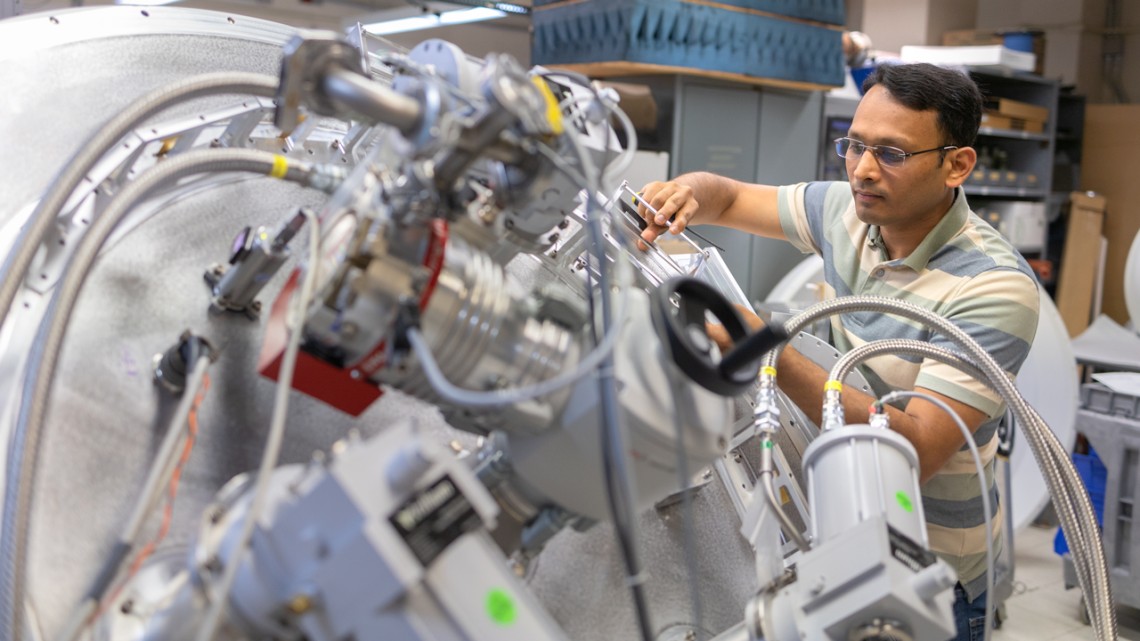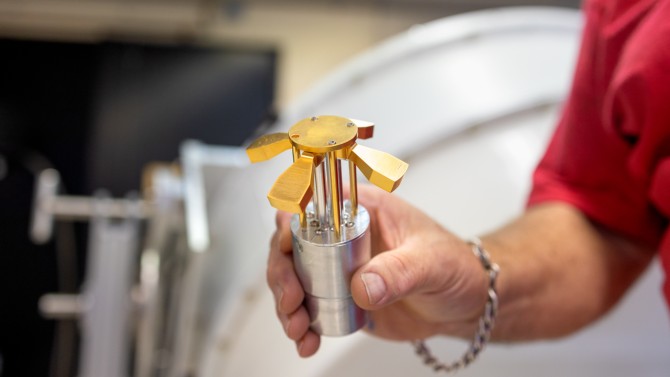
Research associate Amit Vishwas, ’19 Ph.D., inspects the Advanced L-Band Phased Array Camera for Astronomy, an advanced camera built at Cornell that will offer a wide, continuous field of view of the sky.
Cornell-built array camera opens a powerful eye on the sky
By Linda B. Glaser
The Green Bank Telescope in West Virginia – the world’s largest fully steerable telescope – will soon see a vast expansion of its survey capabilities, thanks to a decadelong effort at Cornell to build an advanced camera that will offer a wide, continuous field of view of the sky.
Currently the telescope’s single-dish radio telescope can see only at most a few pixels in the sky at any given time. But the Advanced L-Band Phased Array Camera for Astronomy (ALPACA), built at Cornell, will enable the telescope to observe the sky with 40 pixels simultaneously, radically transforming what the telescope can detect.
ALPACA will enable scientists to study a vast array of astrophysical phenomena, including the detection of fast radio bursts and atomic hydrogen in the environment of galaxies; searches for extra-terrestrial intelligence, especially techno-signatures; and surveys of gas-bearing low mass dark matter haloes in the local universe. It will cover radio waves with frequencies from 1.3 to 1.7 GHz.
The instrument will also contribute significantly to pulsar research, including the discovery of new pulsars, especially the millisecond pulsars used by the NANOGrav collaboration – an international group exploring the low-frequency gravitational wave universe – to detect nanohertz gravitational waves.
“ALPACA is actually a very different way of observing the sky,” said Amit Vishwas ’10, M.Eng.,’14, Ph.D. ’19, research scientist in the Department of Astronomy in the College of Arts and Sciences. “The dipole [antennas] – all 69 of them – act as a phased array and sample the electromagnetic field in the focal plane. This information allows us to then make a beam at any point on the sky over which we have sampled the electromagnetic field.”
While ALPACA won’t be the first radio telescope with many pixels, it will be one of the first, if not the first, of a new generation of phased array receivers that is cryogenically cooled down to 2,0 Kelvin (minus 253 degrees Celsius or 423 degrees Fahrenheit).
“The instrument’s amplifiers also amplify noise, so cooling them decreases the noise level significantly,” said principal investigator Donald Campbell, professor emeritus of astronomy (A&S).
Unlike cryogenic “wet” systems that use liquid nitrogen or helium to cool, ALPACA will be a dry, closed system.
“Liquid helium is becoming very scarce and very valuable, so you want a system where you don’t have to constantly be transferring in cryogens,” said George Gull ’72, research support specialist (A&S). “ALPACA has a compressor and three cryopumps. We use that system like a really fancy air conditioning system to cool everything down. It’s a closed loop and the only thing we’re using is electricity, so we’re not burning off the helium supply of the world.”
Another challenge was designing the 69-dipole ALPACA receiver array. Dipoles are one of the simplest kinds of antenna, said Vishwas, used for things like car antennas. But despite a dipole’s simplicity, designing the array was not a simple task. The dipoles needed to be embedded close to each other in an array so that “they all sort of talk to each other,” said Vishwas. “In order to make all of them work best together, we had to make tradeoffs against the conventional design wisdom for a single dipole.”
Increasing the number of pixels means ALPACA will stream huge amounts of data, which will require a petabyte scale storage system; one day of data will require 700 terabytes of storage. This “running data” of the most recent observations will then be converted into science-ready data products, compressed (reduced in size) and then stored in an archive so they are available for scientists to analyze. The digital back-end is being designed and built by Brigham Young University in Provo, Utah.
ALPACA was originally intended to be installed on the Arecibo telescope in Puerto Rico; after Arecibo collapsed in 2020, the team adapted the instrument for the Green Bank Telescope.
Once ALPACA is installed, it will be a facility instrument, Vishwas said. “Anyone in the world can apply to use it on the Green Bank Telescope.”
The National Science Foundation supported the development of the ALPACA instrument and the digital back-end.
Read the full story on the College of Arts and Sciences website.
Linda B. Glaser is news and media relations manager for the College of Arts and Sciences.
Media Contact
Get Cornell news delivered right to your inbox.
Subscribe

